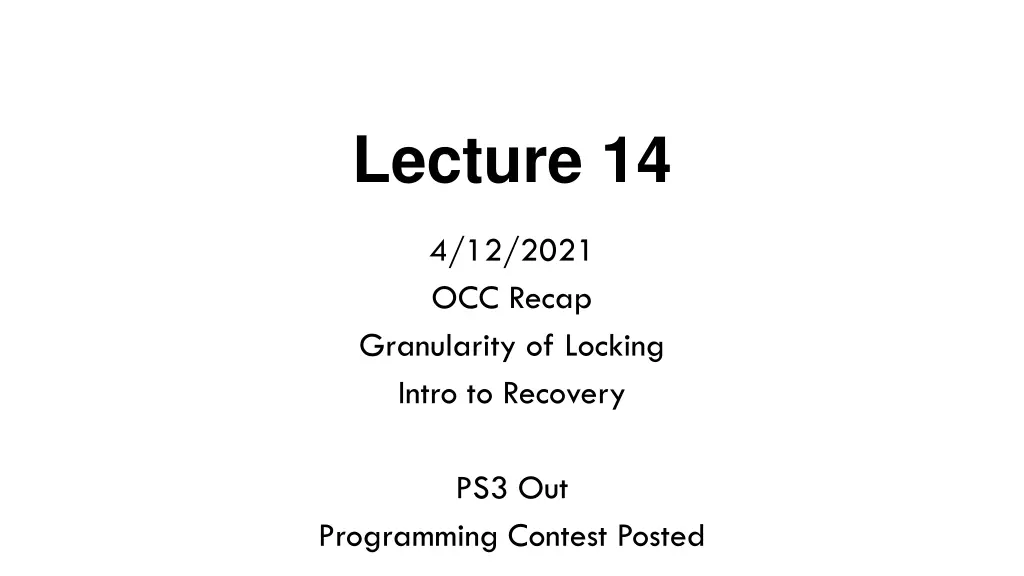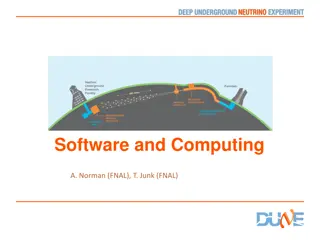
Locking Granularity Overview
Explore the concept of locking granularity and its impact on database transaction management, including insights on optimistic concurrency control and the tradeoffs involved. Gain a deeper understanding of ACID properties and transaction processing for high-performance systems.
Download Presentation

Please find below an Image/Link to download the presentation.
The content on the website is provided AS IS for your information and personal use only. It may not be sold, licensed, or shared on other websites without obtaining consent from the author. If you encounter any issues during the download, it is possible that the publisher has removed the file from their server.
You are allowed to download the files provided on this website for personal or commercial use, subject to the condition that they are used lawfully. All files are the property of their respective owners.
The content on the website is provided AS IS for your information and personal use only. It may not be sold, licensed, or shared on other websites without obtaining consent from the author.
E N D
Presentation Transcript
Lecture 14 4/12/2021 OCC Recap Granularity of Locking Intro to Recovery PS3 Out Programming Contest Posted
Transactions Group related sequence of actions so they are all or nothing - If the system crashes, partial effects are not seen - Other transactions do not see partial effects A set of implementation techniques that provides this abstraction with good performance
ACID Properties of Transactions A tomicity many actions look like one; all or nothing C onsistency database preserves invariants I solation concurrent actions don t see each other s results D urability completed actions in effect after crash ( recoverable )
Optimistic Concurrency Control (OCC) Alternative to locking for isolation Approach: - Store writes in a per-transaction buffer - Track read and write sets - At commit, check if transaction conflicted with earlier (concurrent) txns - Abort transactions that conflict - Install writes at end of transaction Optimistic in that it does not block, hopes to get lucky arrive in serial interleaving
Tradeoff In OCC: - Never have to wait for locks - No deadlocks But... - Transactions that conflict often have to be restarted - Transactions can "starve" -- e.g., be repeatedly restarted, never making progress OCC will do better when the restart rate is low - I.e., when there is less contention Recent work on high performance transaction processing has focused on OCC because - OCC checks can be done between individual transactions - Unlike global shared lock table - Modern OCC systems obtain insane throughput (> 10M xactions / sec)
Today Locking Granularity Introduction to Recovery
Locking Granularity So far, we've used an abstract model of "objects" being read, written, and locked, e.g.: RX WX In practice, X could be a tuple, page, table, or whole database. - Tradeoff between overhead and concurrency
Tradeoff A txn that touches many records will have to acquire many locks! - This adds overhead to each operation A txn that locks a whole table when it only needs to access part of it will limit concurrency Would like to allow: - Txns that lock a few records to use record or page locks - Txns that lock many records to use table locks
Multiple Granularities Complicate Locking Need to ensure different granularities co-exist Non-trivial, e.g.: - T1 shouldn t be able to lock a record in Table A if T2 has write lock on all of A Solutions: - Hierarchy of locks, e.g. Before a txn can lock a lower level in the hierarchy, it needs to hold an intention lock on the higher levels Table Table Page Range Record Record
Intention Locks Suppose T1 wants to read record R1 Needs to acquire intention lock on the Table and Page that T1 is in Intention lock marks higher levels with the fact that a transaction has a lock on a lower level Intention locks - Can be read intention or write intention locks - Prevent transactions from writing or reading the whole object when another transaction is working on a lower level - New compatibility table Table Page Record
Lock compatibility table T2 can t read all of level if T1 updating lower level Reading / updating whole level Reading / updating lower level T1 holds T2 can read all of level if T1 reading lower level S X IX IS T2 trying to acquire T2 can t update all of level if T1 updating lower level S N Y N Y T2 can t update all of level if T1 reading lower level X N N N N IX N N T2 can read / update lower level if T1 is reading / updating lower level (If they try to access same lower-level object, locking at lower level will block) Y Y IS Y N Y Y
Locking Protocol with IS/IX locks Consider transaction T trying to S/X lock record R at level j of hierarchy For each level L in 1 j - 1 - Acquire IS/IX lock on object containing R at level L - Block if not compatible Acquire S/X lock on R To Xlock R: Acquire top down IX Table(R) IX Page(R) R X Release in opposite order (bottom up)
Study Break Hierarchy Table Given this hierarchy And three records on two pages of table T Given the use of intention locks and locking at different granularities, which of the following pairs of transactions would execute without blocking? Page Record Database P1 A B 1. T1: Read P1 2. T1: Write P2 3. T1: Write P1 4. T1: Read P1 T2: Write A T2: Read T T2: Write P2 T2: Write C P2 C Table T
Study Break Hierarchy Table Given this hierarchy And three records on two pages of table T Given the use of intention locks and locking at different granularities, which of the following pairs of transactions would execute without blocking? Page Record Database P1 A B 1. T1: Read P1 2. T1: Write P2 3. T1: Write P1 4. T1: Read P1 T2: Write A T2: Read T T2: Write P2 T2: Write C X P2 C X Table T
Introduction to Recovery What happens during crash: - Memory is reset - State on disk persists After a crash, recovery ensures: - Atomicity: partially finished xactions are rolled back (aborted) - Durability: committed xactions are on stable storage (disk) Brings database into a transaction consistent state, where committed transactions are fully reflected, and uncommitted transactions are completely undone
Why Rollback Uncommitted Transactions? After system crashes, all client connections gone Not generally possible to figure out what work was left to be done Best option: restore DB to a state as if transactions did not occur - Preserves atomicity - Implies that clients must not depend on uncommitted results
Database State During Query Execution Log records start and end of transactions, and contents of writes done to tables so we can solve both problems P1 P2 Log Tables Buffer Manager Disk Memory Problem 2: Some transactions may not have flushed all of their state to tables prior to commit need to REDO Problem 1: Some transactions may have written their uncommitted state to tables need to UNDO After crash, memory is gone!
Why is a Log Needed? Log captures both before and after state of all writes - E.g., page X was X0 is now X1 Also tells us which transactions committed and which did not Why do we need to record write contents? - Without this, can t tell whether a write has been applied or not - Allows us to redo committed writes, if state not in tables on disk - Allows us to undo uncommitted writes, if state in tables on disk
Logical vs Physical Logging REDO REDO UNDO UNDO 0x0012 0002 F00E 0xB007 4789 F8F8 0xEEE0 2020 4447 0x0012 0004 F50E 0xB007 4789 F8F8 0xEEE0 2020 4447 Remove record X from position Y Insert record X into position Y Physical Logging Logical Logging Logical logging is more compact, but it depends on pages fully reflecting (or not reflecting) operations being undone and redone
Write Ahead Logging Log records written before any action is taken - Start or commit transaction - Writing a page to tables on disk (reads are not logged) Why write ahead? - Otherwise, we might: - update a page as a part of an uncommitted xaction, - crash (which should cause us to rollback that update), and - not have any way to tell that the page was updated Write what we plan to do before we do it, and leave enough info in the log so that we can figure out whether we did it or not Note that we do have to write everything twice, but logging is sequential, unlike writes to the DB, which are random
Types of Log Records Start (SOT) Log Sequence Number (LSN), Transaction ID (TID) - LSN is a monotonically increasing log record number End (EOT) LSN, TID, outcome (commit or abort) UNDO LSN, TID, before image REDO LSN, TID, after image For next time: CHECKPOINT CLR LSN, TID, state to limit how much is logged LSN, TID, allows us to restart recovery
Why Do We Sometimes Write Dirty Pages? If we don t write back dirty pages, they must be held in memory for the duration of the xaction Consider a transaction that updates all records in table A DB that writes back dirty pages is said to STEAL STEAL requires UNDO to remove uncommitted txns
Why Not Force All Writes to Tables Before Commit? Slow! Would require us to do many random writes at commit time A DB that doesn t force all writes at commit is NO FORCE (Sequential) logging is sufficient to ensure recoverability, so FORCE is unnecessary for recoverability However, NO FORCE requires REDO to install logged writes to DB
STEAL/NO FORCE UNDO/REDO If we STEAL pages, we will need to UNDO If we don t FORCE pages, we will need to REDO NO FORCE FORCE In SimpleDB, we do FORCE / NO STEAL, and assume DB won t crash between FORCE and COMMIT All commercial DBs do NO FORCE / STEAL for performance reasons UNDO & REDO STEAL UNDO ? NO STEAL REDO UNDO If we FORCE pages, we will need to be able to UNDO if we crash between the FORCE and the COMMIT
Recovery with NO FORCE / STEAL After crash, we must: - REDO winner transactions that had committed - UNDO loser transactions that had not committed Winner are transactions with SOT and COMMIT in log Losers are those with SOT and no EOT Need to REDO winners from start to end Need to UNDO losers in reverse, from end to start Also need to UNDO aborted transactions
3 Phases of Recovery Analysis: Scan log to find winners and losers REDO: Scan log from beginning to end for winners UNDO: Scan log from end to beginning for losers Many possible ways to do this, e.g., UNDO then REDO or REDO then UNDO - Next time will see a specific proposal and analyze why Note that in a properly isolated DB, concurrent txns won t read and write the same pages, if using page locking - So don t need to worry about UNDOing a winner operation on the same page Next time we will talk about how to handle different locking granularities
Example Suppose we have 3 transactions, using NO FORCE, STEAL T1 writes A, commits T2 writes B, aborts T3 write C, system crashes T1 --------------W(A)--------------- Commit T2-------------------------W(B)----------- Abort T3--------W(C)------------------------ crash! Log: SOT (T1) SOT (T2) W(A) S(T3) W(C) W(B) C(T1) A(T2)
Study Break Q1: Given the following log, if the system crashes which transactions are winners? 1 SOT T1 2 SOT T2 3 WA T1 4 COMMIT T1 5 WB T2 6 SOT T3 7 WA T3 8 SOT T4 9 COMMIT T3 10 WC T4 Need to undo T2 and T4 Q2: Which write LSNs will be UNDOne, in which order: A. 10, 7, 5 B. 10, 5 C. 5, 10 D. 5, 7, 10
Next Time: ARIES Considered the gold standard in logging Specifies all the details NO FORCE/STEAL Shows how its possible to make recovery recoverable Shows how to use logical UNDO logging Shows how to handle nested transactions - (which we won't talk about) Shows how to make checkpoints work






